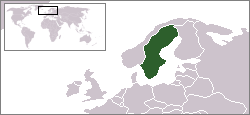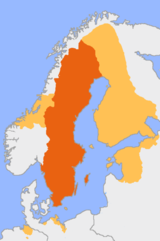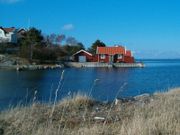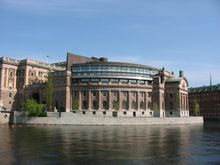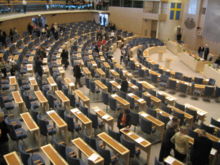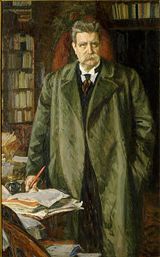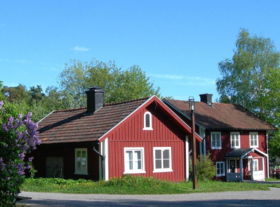Sweden
2007 Schools Wikipedia Selection. Related subjects: Countries; European Countries
| Konungariket Sverige Kingdom of Sweden |
|||||
|
|||||
| Motto: (Royal) För Sverige - I tiden a "For Sweden - With the times" |
|||||
| Anthem: Du gamla, du fria "Thou ancient, thou free" Royal anthem: Kungssången "The King's song" |
|||||
| Capital (and largest city) |
Stockholm |
||||
| Official languages | none ( Swedish de facto)b |
||||
|---|---|---|---|---|---|
| Government | Representative parliamentary democracy under a constitutional monarchy |
||||
| - King | Carl XVI Gustaf | ||||
| - Prime Minister | Fredrik Reinfeldt | ||||
| Consolidation | prehistoric | ||||
| Accession to EU | January 1, 1995 | ||||
| Area | |||||
| - Total | 449,964 km² ( 55th) 173,732 sq mi |
||||
| - Water (%) | 8.67 | ||||
| Population | |||||
| - 2006 estimate | 9,103,551 (September 2006) ( 85th) | ||||
| - 1990 census | 8,587,353 | ||||
| - Density | 20/km² ( 185th) 52/sq mi |
||||
| GDP ( PPP) | 2005 estimate | ||||
| - Total | $270.516 billion ( 35th) | ||||
| - Per capita | $29,898 ( 19th) | ||||
| GDP (nominal) | 2005 estimate | ||||
| - Total | $358,819 billion ( 20th) | ||||
| - Per capita | $39,694 ( 9th) | ||||
| HDI (2006) | |||||
| Currency | Swedish krona ( SEK) |
||||
| Time zone | CET ( UTC+1) | ||||
| - Summer ( DST) | CEST ( UTC+2) | ||||
| Internet TLD | .sec | ||||
| Calling code | +46 | ||||
| a För Sverige - I tiden has been adopted by Carl XVI Gustaf as his personal motto. Former king Gustaf VI Adolf's motto was Plikten framför allt, "Duty above all". b The Swedish language is de facto the national language. Five other languages are officially recognized as minority languages. c The .eu domain is also used, as it is shared with other European Union member states. |
|||||
The Kingdom of Sweden ( Swedish: Konungariket Sverige ) is a Nordic country in Scandinavia. It is bordered by Norway in the west, Finland in the northeast, the Skagerrak Strait and the Kattegat Strait in the southwest, and the Baltic Sea and the Gulf of Bothnia in the east. It is connected to Denmark in the southwest by the Oresund Bridge.
Sweden has a low population density except in its metropolitan areas, with most of the inland consisting of forests. The country has large natural resources of water, timber, and iron ore. Its citizens enjoy a high standard of living in a country that is generally perceived as modern and liberal.
Following the end of the Viking Age, Sweden became part of the Kalmar Union together with Denmark and Norway (Finland at this time was a part of the Swedish kingdom). Sweden left the union in the beginning of the 16th century, and more or less constantly battled its neighbours for many years, especially Russia and the still united Denmark-Norway, which never completely accepted Sweden leaving the union. In the 17th century Sweden extended its territory through warfare and became a Great Power, twice its current size. By 1814 Sweden had lost its empire as well as Finland, previously an integral part of the Kingdom of Sweden. Since 1814, Sweden has been at peace, adopting a non-aligned foreign policy in peacetime and neutrality in wartime.
Sweden has been a major European exporter of iron, copper and timber since the Middle Ages. However, improved transportation and communication allowed it to utilize natural assets from different parts of the country on a far larger scale, most notably timber and iron ore. Economic liberalization as well as universal schooling contributed to the rapid industrialization and by the 1890s the country had begun to develop an advanced manufacturing industry. In the 20th century a welfare state emerged. Sweden usually ranks among the top nations in the UN Human Development Index.
History
Prehistory
Soon after the end of the last ice age, Sweden became populated by hunter-gatherers and then farmers during the Stone Age (10 000 BC – 1700 BC). This was followed by the Bronze Age (1700 - 500 BC) and Iron Age (500 BC - AD 1050). Societies in Sweden remained on the preliterate tribal and chiefdom levels to the 1st millennium AD.
Sweden was first mentioned in the 1st century, by Roman historian Tacitus, who wrote that the Suiones tribe lived out in the sea and were powerful in both arms and ships. This referred to the inhabitants of eastern Sweden: Svealand, primarily around lake Mälaren. From this tribe, Sweden derived its name (see Etymology of Sweden). The southern parts, on the other hand, were inhabited by the Geats in the Götaland territory, and Beowulf speaks of semi-legendary Swedish-Geatish wars in the 6th century. The northern part, Norrland, was sparsely populated by Sami and possibly different tribes/people related to the Finns.
During the Viking Age of the 9th and 10th century, Swedish vikings travelled east setting their mark on the Baltic countries and Russia, whose name probably comes from the Slavic name for these Vikings: Rus. This name is probably derived from Roslagen, and is also reflected in the modern Finnish and Estonian name for Sweden: Ruotsi and Rootsi, respectively. Their routes passed the rivers of Russia down south to Constantinople and southern Europe.
Middle Ages
With Christianization in the 11th century, the country became consolidated, with its centre in the agricultural regions of Östergötland and Västergötland and later on also in the water-ways of the northern Baltic and the Gulf of Finland. In the 14th century Sweden, like the rest of Europe, was struck by the Black Death (the Plague), with all its effect.
During the Middle Ages, the expansion of Sweden into the northern wilderness of Laplandia and Norrbotten, the Scandinavian peninsula, and present-day Finland continued. Area of present day Finland was a part of Sweden proper from the early thirteenth century until 1809.
In 1389, Norway, Denmark and Sweden were united under a single monarch in a treaty known as the Kalmar Union. After several wars and disputes between these nations, King Gustav I of Sweden ( House of Vasa) broke free in 1521 and established a nation state, considered the foundation of modern Sweden. Shortly afterwards he rejected Catholicism and led Sweden to the Protestant Reformation. Gustav I is considered to be Sweden's " Father of the Nation".
Great power
The 17th century saw the rise of Sweden as one of the Great Powers in Europe, because of successful participation, initiated by King Gustav II Adolph, in the Thirty Years' War and by Carl X Gustav of Sweden in the The Deluge of Poland. During this time Sweden was a power of some importance in northern Europe, but its overall standing was not comparable to that of Europe's leading nations. Sweden also acquired several mighty enemies and the great power status crumbled in the 18th century. Imperial Russia took the reins of northern Europe in the Great Northern War, and finally in 1809 when the autonomous Grand Duchy of Finland was created out of the eastern half of Sweden.
After Denmark was defeated in the Napoleonic wars, Norway was ceded to Sweden in the Treaty of Kiel. Norway had meanwhile declared itself independent and this led to the Campaign against Norway, which was fought in 1814. It ended with the Convention of Moss, which forced Norway into a union with Sweden that was not dissolved until 1905. But the campaign also signified the last of the Swedish wars and its 200 years of peace are arguably unique in the world today.
Modern history
The 18th and 19th centuries saw a significant population increase, which the writer Esaias Tegnér in 1833 famously attributed to "the peace, the (smallpox) vaccine, and the potatoes" , with the population doubling between 1750 and 1850. Many looked towards America for a better life, and although not affluent, many Swedes had sufficiently high incomes to be able to afford the boat tickets necessary to make the journey across the Atlantic. It is believed that between 1850 and 1910 more than one million Swedes moved to the United States. In the early 20th century, more Swedes lived in Chicago than in Gothenburg (Sweden's second largest city). Most Swedish immigrants moved to the Midwest United States, with a large population in Minnesota. Some Swedes also moved to Canada.
Sweden was traditionally less developed than Western Europe (though more affluent than much of Eastern and Southern Europe); industrialization began in earnest after 1870. During the late 19th century, Sweden was influenced by Protestant temperance movements, mainly of American origin. As a result of their intense propaganda, it is often claimed that alcohol consumption was unusually high in Sweden at this time. However, there is no factual ground for believing that alcohol consumption was higher than in other comparable countries.
Strong grassroots movements sprung up during the latter half of the 19th century (unions, temperance groups, and independent religious groups). They were all based on democratic principles and built a strong base for Sweden's migration into a modern parliamentary democracy, achieved by the time of World War I. As the Industrial Revolution progressed during the century, people gradually began moving into cities to work in factories, and became involved in Socialist unions. A Socialist revolution was avoided in 1917, following the re-introduction of Parliamentarism, and the country was democratized.
Recent history
By the 1930s Sweden had achieved one of Europe's highest living standards.
Sweden remained neutral during World War I and World War II as claimed by itself, although its neutrality during World War II has been highly debated and not accepted by most of the world. Sweden was forcibly under German influence for most of the war, as ties to the rest of the world were cut off through blockades. The Swedish government felt that it was in no position to openly disagree with Germany, but it did attempt to help the Allies in secret. Many refugees were saved partly because of Sweden's neutrality, among them many Jews. (See further Sweden during World War II).
Following the war, Sweden took advantage of intact industrial base, social stability and its natural resources, making it possible to expand its industry to supply the rebuilding of Europe, leading it to be one of the richest countries in the world by 1960. Sweden was part of the Marshall Plan but continued to stay non-aligned during the Cold War, and is still not a member of any military alliance. During most of the post-war era, the country was governed by the Swedish Social Democratic Party and established a welfare state, striving for a "well being for all"-policy.
Sweden joined the European Union in 1995. During the Cold War, Europe's non-aligned Western countries, except Ireland, had considered membership unwise as the then European Community, although not involved in military co-operation, was strongly associated with NATO countries; following the end of the Cold War, Sweden, Austria and Finland joined. However, in a 2003 consultative referendum, Swedish citizens declined to adopt the Euro. Sweden remains non-aligned militarily although it participates in some joint military excercises with NATO (and other) countries and has extensive cooperation with other European countries in the area of defence technology and defence indstry. Sweden has a long history of participating in international military operations, including most recently, Afghanistan, where Swedish troops are under NATO command, and in EU sponsored peace keeping operations in Kosovo and Bosnia.
Sweden's economic performance worsened beginning in the 1970s. Following a recession in the early 1990s as a result of global economic slowdown, measures were taken to liberalize the economy. Although the basis of the welfare state have been maintained a number of economic reforms have been implemented, including a reform of the pension system, privatization of state-owned companies and liberalization of markets. The economic situation has improved significantly since then with growth rates outpacing those of the Eurozone.
Sweden has had two political murders in recent history. Prime Minister Olof Palme in 1986, and foreign-minister Anna Lindh in 2003.
Geography
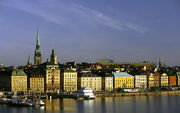
At 449,964 km² (173,720 square miles), Sweden is the 55th largest country in the world and the 5th largest in Europe. The country is somewhat larger than the U.S. state of California, and in 2006 it had a population of 9.1 million people.

East of Sweden lies the Baltic Sea and the Gulf of Bothnia, providing a long coastline, and mellowing the climate. To the west is the Scandinavian mountain chain (Skanderna), a range that separates Sweden from Norway.
The southern part of the country is predominantly agricultural, with forests covering a larger percentage of the land the further north one goes. Population density is also higher in southern Sweden, with centres being in the valley of lake Mälaren and the Öresund region.
Gotland and Öland are the largest islands of Sweden.
Sweden enjoys a mostly temperate climate despite its northern latitude, mainly because of the Gulf Stream. In the south of Sweden, leaf-bearing trees are prolific, further north pines, spruces and in the very north hardy birches dominate the landscape. In the mountains of northern Sweden a sub-Arctic climate predominates. North of the Arctic Circle, the sun never sets for part of each summer, and in the winter, night is unending for a corresponding period.
Administrative divisions
Counties
Sweden is divided into 21 counties or län. They are Stockholm County, Uppsala County, Södermanland County, Östergötland County, Jönköping County, Kronoberg County, Kalmar County, Gotland County, Blekinge County, Skåne County, Halland County, Västra Götaland County, Värmland County, Örebro County, Västmanland County, Dalarna County, Gävleborg County, Västernorrland County, Jämtland County, Västerbotten County and Norrbotten County.
Each has a County Administrative Board or länsstyrelse (the first Swedish County Administrative Board was made up by the Swedish Prime minister Axel Oxenstierna in 1634), which is appointed by the Government. In each county there is also a separate County Council or landsting, which is the municipal representation appointed by the county electorate. Each county further divides into a number of municipalities or kommuner, making a total of 290 municipalities, in 2004. There are also older historical divisions of Sweden, primarily into the 25 provinces and three lands. These divisions are still significant.
Largest municipalities
Denotes inhabitants in the municipality (kommun) area. Area is in km². The figures are as of March 31, 2006.
| Rank | Municipality | Population | Land Area | Density |
|---|---|---|---|---|
| 1 | Stockholm | 774,411 | 187.74 | 4,124.91 |
| 2 | Göteborg | 487,028 | 450.71 | 1,080.58 |
| 3 | Malmö | 272,634 | 155.56 | 1,752.60 |
| 4 | Uppsala | 183,911 | 2,189.10 | 84.01 |
| 5 | Linköping | 137,949 | 1,435.80 | 96.08 |
| 6 | Västerås | 132,344 | 962.78 | 137.46 |
| 7 | Örebro | 128,170 | 1,380.11 | 92.87 |
| 8 | Norrköping | 124,729 | 1,503.61 | 82.95 |
| 9 | Helsingborg | 122,349 | 346.25 | 353.35 |
| 10 | Jönköping | 121,229 | 1,488.75 | 81.43 |
| 11 | Umeå | 110,919 | 2,331.39 | 47.58 |
| 12 | Lund | 102,452 | 430.27 | 238.11 |
| 13 | Borås | 99,645 | 915.22 | 108.88 |
| 14 | Sundsvall | 94,121 | 3,208.70 | 29.33 |
| 15 | Gävle | 92,257 | 1,615.07 | 57.12 |
Demographics
Sweden has one of the world's highest life expectancies. As of approximately August 12, 2004, the total population of Sweden for the first time exceeded 9,000,000, according to the SCB. As of February 2006, the population was 9,060,430. About 86.7% of the population is ethnic Swedish. The largest non-ethnically Swedish groups are the Finns, who make up about 2% of the population. Other significant ethnic groups are from the other Scandinavian countries, the former Yugoslavia, and the Middle East. An additional group that has a strong say based on tradition is the indigenous Sami people, mostly living in rural Lapland and amounting to about 17,000 people.
Sweden has been transformed from a nation of emigration ending after World War I to a nation of immigration from World War II onwards. Currently, almost 12% of the residents were born abroad, and about one fifth of Sweden's population are either immigrants or the children of immigrants. The largest immigrant groups are from Finland, the former Yugoslavia, the Middle East and other Nordic Countries, in that order. This reflects the inter-Nordic migrations, earlier periods of labour immigration, and later decades of refugee and family immigration.
Soviet intervention against the 1956 Hungarian Revolution and the 1968 Czechoslovak liberalization resulted in the first surges of intellectual political refugees. Some American deserters from the Vietnam War also found refuge among the Swedes, who in international politics took a clear stand against what they typically viewed as imperialism executed by both the Soviet Union and the United States. Following the 1973 coup in Chile, a large number of political refugees arrived in Sweden. Others came from South American countries like Argentina and Uruguay following the rise of military dictatorships. Sweden has also taken in refugees from Iran, Iraq and Palestine.
Language
Swedish is a North Germanic language, related and very similar to Danish and Norwegian, but differing in pronunciation and orthography. Sweden has no official language but Swedish holds a de facto status as such. The dominant language has always been Swedish and there has previously never been a political need to make it an official language. However, with the recognition of five minority languages of Sweden ( Finnish, Meänkieli, Sami, Romani and Yiddish) on April 1, 2000, the issue of whether Swedish should be declared the official language was raised. On December 7, 2005, the parliament voted on this issue, but with a count of 147 to 145 because of voting errors by some members of parliament the proposal to make Swedish the official language failed. It was, however, strengthened as the principal language in that same proposal.
A majority of Swedes, especially those born after World War II, are able to understand and speak English thanks to trade links, the popularity of overseas travel, a strong Anglo-American influence and the tradition of subtitling rather than dubbing foreign television shows and films. English became a compulsory subject for secondary school students studying natural sciences as early as 1849 and has been a compulsory subject for all Swedish students since the late 1940s. Depending on the local school authorities, English is currently a compulsory subject from third until ninth grade, and all students continuing in secondary school study English for at least another year. Most students also learn one and sometimes two additional languages; the most popular being Spanish, German, French. Some Norwegian is also taught as a part of the Swedish course taught to native speakers of Swedish to empasize differences and similarities between the two languages.
Politics
Political system
Sweden is a constitutional monarchy, in which King Carl XVI Gustaf is head of state, but royal power has long been limited to official and ceremonial functions.
The nation's legislature is the Swedish Parliament (Riksdag), with 349 members. Parliamentary elections are held every four years.
Sweden has been a monarchy for almost a millennium, with its taxation controlled by the Riksdag (parliament). It consisted of two chambers, made up by representatives from the 4 estates: clergy, nobility, townsmen and peasants, until 1866 when Sweden became a Constitutional monarchy with a bicameral parliament. Its First Chamber was indirectly elected by local governments, and the Second Chamber directly elected in national elections every four years.
Legislative power was (symbolically) shared between king and parliament until 1975. In 1971 the Riksdag became unicameral. Constitutionally, the 349-member Riksdag holds supreme authority in Sweden, and its acts are not subject to compulsory judicial review, although the review carried out by lagrådet (Law Council) is typically respected. Acts of the parliament must be made inapplicable at every level if they are obviously against constitutional laws.
Legislation may be initiated by the Cabinet or by members of Parliament. Members are elected on the basis of proportional representation for a four-year term. The Constitution of Sweden can be altered by the Riksdag, which requires a supermajority and confirmation after the following general elections. Sweden has three other constitutional laws: the Act of Royal Succession, the Freedom of Press Act and the Fundamental Law on Freedom of Expression.
Executive power was shared between the King and a noble Privy Council until 1680, followed by the King's autocratic rule initiated by the common estates of the Parliament. As a reaction to the failed Great Northern War, Parliamentarism was introduced in 1719, followed by three different flavours of Constitutional Monarchy in 1772, 1789 and 1809, the latter granting several civil liberties. The monarch remains as the formal, but merely symbolic head of state with ceremonial duties.
The Swedish Social Democratic Party has played a leading political role since 1917, after Reformists had confirmed their strength and the revolutionaries left the party. After 1932, the Cabinets have been dominated by the Social Democrats. Only four general elections (1976, 1979, 1991 and 2006) have given the centre-right bloc enough seats in Parliament to form a government. It is considered the reason for the Swedish post-war welfare state, with government expenditure of slightly more than 50% of the gross domestic product. In the 2006 general election the Moderate Party, allied wih the Centre Party, Liberal People's Party, and the Christian Democrats, with a common political platform, won a majority of the votes. Together they have formed a majority government under the leadership of the Moderate party's leader Fredrik Reinfeldt.
The following political parties hold seats in the Riksdag (the most recent elections were held in September 2006; the next elections will be held in September 2010):
- Socialdemokraterna (s, Social Democrats): 130 seats, 35.0% (2002: 39.8% of votes, 144 seats)
- Moderaterna (m, Moderates): 97 seats, 26.2% (2002: 15.2% of votes, 55 seats)
- Centerpartiet (c, Centre Party): 29 seats, 7.9% (2002: 22 seats, 6.1% of votes)
- Folkpartiet liberalerna (fp, Liberal Party): 28 seats, 7.5% (2002: 13.3% of votes, 48 seats)
- Kristdemokraterna (kd, Christian Democrats): 24 seats, 6.6% (2002: 33 seats, 9.1% of votes)
- Vänsterpartiet (v, Left Party): 22 seats, 5.8% (2002: 28 seats, 8.3% of votes)
- Miljöpartiet (mp, Greens): 19 seats, 5.2% (2002: 17 seats, 4.6% of votes)
- Other parties (SD, FI, Piratpartiet, Junilistan, Sjukvårdspartiet) 5.7%
Sweden has a history of strong political involvement by ordinary people through its "popular movements" ( Folkrörelser in Swedish), the most notable being trade unions, the women's movement, the temperance movement, and - more recently - sports movement. Election turnout in Sweden has always been high in international comparisons, although it has declined in recent decades, and is currently around 80% (80.11 in Sweden general election, 2002).
Some Swedish political figures that have become known worldwide include Raoul Wallenberg, Folke Bernadotte, Dag Hammarskjöld former Secretary General of the United Nations, Olof Palme, former Prime Minister, Carl Bildt former Prime Minister and currently Foreign minister, Jan Eliasson the President of the General Assembly of the United Nations and Hans Blix former IAEA inspector in Iraq.
Energy politics
The 1973 oil crisis strengthened Sweden's commitment to decrease dependence on imported fossil fuels. Since then, electricity has been generated mostly from hydropower and nuclear power. Among other things, the accident of Three Mile Island Nuclear Generating Station ( USA) prompted the Swedish parliament to hold a referendum on nuclear power. The referendum led to a decision that no further nuclear power plants should be built and that a nuclear power phase-out should be completed by 2010. As of 2005, the use of renewables amounted to 26% of the energy supply in Sweden, most important being hydropower and, on a far smaller scale, biomass. In 2003, electricity from hydropower accounted for 53 TWh and 40% of the country's production of electricity with nuclear power delivering 65 TWh (49%). At the same time, the use of biofuels, peat etc. produced 13 TWh of electricity.
In March 2005, an opinion poll showed that 83% supported maintaining or increasing nuclear power. Since then however, reports about radioactive leakages at a nuclear waste store in Forsmark, Sweden, have been published. This does not seem to have changed the public support of continued use of nuclear power.
Sweden decided to phase out nuclear fission before 2020, although it is very unlikely that this will happen.
Foreign policy
Throughout the 20th century, Swedish foreign policy was based on the principle of non-alignment in peacetime and neutrality in wartime.
Sweden has been known as one, if not the most diplomatically neutral state during times of war. Dating back to World War II Sweden did not favour any one side. This has been disputed by many since in effect Sweden allowed the Nazi regime to use its railroad system to transport troops and goods, especially iron ore from the rich mines in northern Sweden, something the German war machine was in desperate need of. This also carries on to Cold War era politics in which Sweden was not under the Warsaw Pact and received only minimal aid from the Marshall Plan and remained neutral for quite some time. Sweden was also known to be the first western nation to detect unusually high radiation levels in the atmosphere, which later was confirmed to have been the residual nuclear fallout from the Chernobyl accident.
During the early Cold War era, Sweden combined its policy of non-alignment with a low profile in international affairs. At the same time, the country maintained relatively close informal connections with the Western bloc, especially in the realm of intelligence exchange. In 1952 a Swedish DC-3 was shot down over the Baltic sea by a Soviet Fighter. Later investigations revealed that the plane was actually gathering information for NATO. Another plane, a Catalina search and rescue craft, was sent out a few days later and shot down by the Soviets as well.
Beginning in the late 1960s, Sweden for a period attempted to play a more significant and independent role in international relations. This involved significant activity in international peace efforts, especially through the United Nations, and in support to the Third World. Since the murder of Olof Palme in 1986 and the end of the Cold War, this has been significantly toned down, although Sweden is still comparatively active in peace keeping missions and maintains a generous foreign aid budget.
In 1981 a Soviet Whiskey class submarine ran aground close to the Swedish naval base at Karlskrona in the southern part of the country. It has never been clearly established whether the submarine ended up on the shoals through a navigational mistake or if it was a matter of espionage against Swedish military potential. The incident triggered a diplomatic crisis between Sweden and the Soviet Union.
Since 1995 Sweden has been a member of the European Union, and as a consequence of a new world security situation the country's foreign policy doctrine has been partly modified, with Sweden playing a more active role in European security co-operation as well.
Economy
Swedens economy is in a phase of growth (2006) and features a modern distribution system, excellent internal and external communications, and a skilled labour force. Timber, hydropower, and iron ore constitute the resource base of an economy heavily oriented toward foreign trade. The country has announced its intention to end its dependency on oil by 2020.
The engineering sector accounts for 50% of output and exports. Telecommunications, the automotive industry and the pharmaceutical industries are of great importance. Agriculture accounts for only 2% of GDP and 2% of the jobs.
Sweden's industry is overwhelmingly in private control; unlike some other industrialized Western countries, such as Austria and Italy, publicly owned enterprises were always of minor importance. 80% of the workforce is organized through the trade-unions which have the right to elect two representatives to the board in all Swedish companies with more than 25 employees. The public and the trade-union controlled pension funds, non-profit organizations and the reserve funds of the trade-unions own more than 50% of Sweden capital.
The government's commitment to fiscal discipline resulted in a substantial budgetary surplus in 2001; however, this was cut by more than half in 2002 because of the global economic slowdown and a decline in revenue coupled with an increase in government spending. The Swedish Riksbank is focusing on price stability with its inflation target of 2%. Growth is expected to reach 3.3% in 2006. High taxes have however ensured a higher degree of government influence on household consumption decisions than in most other Western nations. Public sector spending amounts to 53% of the GDP; the high figure primarily reflects the large transfer payments of the Swedish welfare state.
Swedish unemployment figures are highly contested, with the Social-Democrats defending the official figure of 5.4% (as of 2006) and the centre-right Alliance for Sweden claiming a much higher figure. These numbers do not, however, include unemployed people in government programmes (about 2% of the workforce), people on extended sick-leave, those in early retirement or those outside the unemployment system. Unemployment is higher amongst younger people. Some analysts speculate that the unemployment rate for younger people can be as high as 45%. Many Swedes work abroad in Denmark, Norway and even the UK, where they are desired and viewed as a skilled workforce. Because of the contradiction - unemployment and a growing commercial enterprise economy, politicians and analysts often speak of the "jobless growth".
Sweden is known for having an even distribution of income, with a Gini coefficient at 0.21 in 2001 (one of the most even income distributions in the industrialized world). However Sweden still bears scars from the economic crisis in the 1990s, induced by a glitch in the economic system and poor leadership. The crisis resulted in thousands of people unemployed and a great national debt. Two remains of the event are the great economic segregation in the country and the national debt of approximately 1245 billion Swedish Krona (approx. 133 billion €, 2006.09).
Welfare state
In recent years, economic liberalization has ensured that Sweden is now more similar to other high tax European countries. However, some still claim that the Scandinavian model is mid-way between socialism and capitalism, or the most developed form of capitalism.
Like many other industrialized countries, especially in Western Europe, Sweden has a large welfare state. However, it is unusually extensive in Sweden. The state provides for tax-funded childcare, parental leave, a ceiling on health care costs, tax-funded education (all levels up to, and including university), retirement pensions, tax-funded dental care up to 20 years of age and sick leave (partly paid by the employer). Parents are entitled to a total of 480 days partly paid leave between birth and the child's eighth birthday, with 60 days reserved specifically for each parent, in effect providing the father with two so called "daddy-months". In addition, the ceiling on health care costs makes it easier, relative to other nations, for Swedish workers to take time off for medical reasons.
The Swedish welfare system remains extensive, but a recession in the 1990s forced an introduction of a number of reforms, such as education vouchers in 1992 and decentralization of some types of healthcare services to municipal control.
The welfare state requires high taxes. Since the late 1960s, Sweden has had the highest tax quota (as percentage of GDP) in the industrialized world, but today the difference is only a couple of percentage points of GDP above that of other high-tax countries such as France, Belgium and Denmark. Sweden has a two step progressive tax scale with a municipal income tax of about 30% and an additional high-income state tax of 20-25% when a salary exceeds roughly 300 000 SEK per year. The employing company pays an additional 32% of an "employer's fee". In addition, a national VAT of 25% or 18% is added to many things bought by private citizens, with the exception of food (12% VAT), transportation, and books (6% VAT). Certain items are taxed at higher rates, e.g. petrol/diesel and alcoholic beverages.
Education
As part of its social welfare system, Sweden provides an extensive childcare system that guarantees a place for all young children from 1-5 years old in a public day-care facility (förskola or dagis). Between ages 6-16, children attend compulsory comprehensive school, divided in three stages. After completing the ninth grade, 90% continue with a three year upper secondary school (gymnasium) leading sometimes to a vocational diploma and sometimes to the qualifications for further studies at a university or university college (högskola).
Religion
Before the 11th century, people of Sweden adhered to Norse paganism, worshipping Æsir gods, with its centre at the Temple in Uppsala. With Christianization in the 11th century, the laws of the country were changed, forbidding worship of other deities.
After the Protestant Reformation in the 1530s the Church and State were united, abolishing the authority of the Roman Catholic bishops, and in the long run allowed only Lutheranism to prevail. This process was not completed until the Uppsala Synod 1593. During the era following the Reformation, usually known as the period of Lutheran Orthodoxy, in the 17th century, small groups of non-Lutherans, especially Calvinist Dutchmen and Walloons who played a significant role in trade and industry, were quietly tolerated as long as they kept a low religious profile. The Sami originally had their own shamanistic religion, but they were converted to Lutheranism by Swedish missionaries in the 17th and 18th centuries.
Not until liberalization in the late 18th century, were believers of other faiths, including Judaism and Catholicism, allowed to openly live and work in Sweden, although it remained illegal until 1860 for Lutheran Swedes to convert to another religion. The 19th century saw the arrival of various evangelical free churches, and, towards the end of the century secularism began attracting attention, leading people to distance themselves from Church rituals. Leaving the Church of Sweden became legal with the so-called dissenter law of 1860, but only under the provision of entering another denomination. The right to stand outside any religious denomination was established in the Law on Freedom of Religion in 1951. Today about 78% of Swedes belong to the Church of Sweden, but the number is decreasing by about one per cent every year, and Church of Sweden services are sparsely attended (hovering in the single digit percentages of the population). The reason for the large number of inactive members is that until 1996, all children became members automatically at birth, if at least one of their parents were a member. Since 1996, all children that are baptised become members. Some 275,000 Swedes are today members of various free churches (where congregation attendance is much higher), and, in addition, immigration has meant that there are now some 92,000 Roman Catholics and 100,000 Eastern Orthodox Christians living in Sweden. Due to immigration, Sweden also has a significant Muslim population. As many as 500,000 are Muslims by tradition and between 80,000 - 400,000 of these are practising Muslims. (See also Islam in Sweden)
According to the most recent Eurostat "Eurobarometer" poll, in 2005, only 23% of Swedish citizens responded that "they believe there is a god", whereas 53% answered that "they believe there is some sort of spirit or life force" and 23% that "they do not believe there is any sort of spirit, god, or life force".
Culture
Swedish authors of worldwide recognition include Henning Mankell, Carolus Linnaeus (the father of botany), Emanuel Swedenborg, August Strindberg, Selma Lagerlöf, Vilhelm Moberg, Harry Martinson and Astrid Lindgren, the author of the Pippi Longstocking books.
Sweden made its first noticeable contributions to Western culture and science in the mid 18th century. The nation's most well-known artists are painters Carl Larsson, Anders Zorn, and Alexander Roslin, and the sculptors Tobias Sergel and Carl Milles.

Some well-known inventions and discoveries, historical and modern, were made by Swedes. Some notable figures are Alfred Nobel, Anders Celsius, Baltzar von Platen, Carl Wilhelm Scheele, Jöns Jakob Berzelius, John Ericsson, Anders Jonas Ångström, Lars Magnus Ericsson, Svante Arrhenius, Arvid Carlsson, Håkan Lans.
Swedish 20th century culture is noted by pioneering works in the early days of cinema, with Mauritz Stiller and Victor Sjöström. In the 1920s–1980s, the filmmakers Ingmar Bergman and Bo Widerberg received Academy Awards, and actresses Greta Garbo, Ingrid Bergman, Ann-Margret, Lena Olin, Zarah Leander, and Anita Ekberg made careers abroad. The actors Max von Sydow, Stellan Skarsgård, Dolph Lundgren and Peter Stormare are also worth mentioning. More recently, the films of Lukas Moodysson and Lasse Hallström have received international recognition.
Throughout the 1960s and 1970s Sweden was perceived as an international leader in what is now referred to as the " sexual revolution", with gender equality particularly promoted. In present time the rate of single-people is one of the highest in the world. Some Swedish films reflected a liberal view of sexuality, including scenes of love making that caught international attention, and introduced the concept of the "Swedish sin". However, Sweden was at that time not as sexually liberal as people believed. Sweden has also become, in recent decades, fairly liberal regarding homosexuality, as is reflected in the popular acceptance of films such as Fucking Åmål (In English: Show Me Love), and the popular writer Jonas Gardell, among others. In Sweden many gay and lesbian celebrities live openly without causing a stir, much as in many other Western countries. Sweden has a civil union for same sex couples ("registered partnership"), but unlike some countries, such as the Netherlands and Norway, Sweden does not yet allow same sex marriages.
Music
Sweden has a rich musical tradition, ranging from medieval folk ballads to house music. The music of the Vikings has been lost to history, although there have been historical attempts to recreate how it could have sounded based on instruments found in Viking sites. Instruments used were the lur (a wooden trumpet), simple string instruments, wooden flutes and drums. It is possible that the Viking musical legacy lives on in some of the old Swedish folk music.
Carl Michael Bellman, Wilhelm Stenhammar, Wilhelm Peterson-Berger, Hugo Alfvén, Franz Berwald, and Johan Helmich Roman are among Sweden's great classical composers. The best-known opera singers are the 19th century soprano Jenny Lind and the 20th century tenor Jussi Björling, who had great success abroad. Björling is considered by many to be the epitome of a great tenor. Also sopranos Christina Nilsson, Birgit Nilsson, and tenor Nicolai Gedda, baritone Håkan Hagegård and the contemporary mezzo-soprano Anne-Sofie von Otter have become known in the world of opera.
Evert Taube, Povel Ramel, Cornelis Vreeswijk are all popular modern trubadors, considered to be classics in Swedish music.
ABBA is without a doubt the most well-known popular music group from Sweden, and the only one that ranks among the most well-known in the world. ABBA was made up of Agnetha Fältskog, Björn Ulvaeus, Anni-Frid Lyngstad, and Benny Andersson, whose names form the word ABBA. With ABBA, Sweden entered into a new era, in which Swedish pop music gained international prominence. Sweden is, after the US and the UK, the largest producer of music in the world. Some of the most successful post-ABBA popular music artists from Sweden are Roxette, Ace of Base, Carola Häggkvist, Army of Lovers, Robyn, A*Teens, The Cardigans, Europe, Alcazar, and guitarist Yngwie Malmsteen. The Boppers A number of bands with less emphasis on pop music have come out of the country in recent years, including Eskobar, Clawfinger, The Sounds, José González, The Hives, Hardcore Superstar, Millencolin, Sahara Hotnights, The Hellacopters, Kent, The Ark, Infinite Mass, Love is All, and Looptroop. Such has been the success of music abroad that clubs specializing in Swedish music have sprung up in major cities like, Berlin, Barcelona and London where the likes of Tack!Tack!Tack! the Monthly Swedish Music club is produced.
In underground circles, Sweden is known for a large number of heavy metal (mostly death metal and melodic death metal), as well as Progressive bands. Prominent metal acts include Dark Tranquillity, Opeth, Hypocrisy, In Flames, Meshuggah, The Haunted, At the Gates, Soilwork, Scar Symmetry, Evergrey, Ravaged, Katatonia, Pain Of Salvation, Hammerfall, Arch Enemy, Blindside, Jerusalem, Unleashed, Amon Amarth, Vintersorg, Entombed, Mister kite, Lost Horizon and Deathstars.
In the synth world, the band S.P.O.C.K is still active after 18 years. Sweden is also responsible for the Swechno scene, offering a distinct house and techno sound, of which artists like Adam Beyer is famous. More recently, the so-called Swedish House Mafia including Steve Angello, Sebastian Ingrosso, Axwell, and Eric Prydz have topped the house music charts and DJ top 10s around the world. Also worth mentioning is Joakim Thåström and his punk band Ebba Grön. Sweden is also home to several influential emo and hardcore punk bands, such as Fireside, The Last Days Of April, Kelly 8 and landmark post-hardcore band Refused.
In the world of jazz, Monica Zetterlund achieved international renown, both as a singer and as an actress. Other names worth mentioning are Alice Babs, Jan Johansson, Arne Domnerus, George Riedel, Putte Wickman, George Wadenius, Bengt Hallberg, Lars Gullin, Ulf Wakenius, Magnus Lindgren, and Esbjörn Svensson Trio.
Some groups and artists who are not as well-known internationally but have been well-known in Sweden are Peter Jöback, Lill-Babs Svensson, Ted Gärdestad, Gyllene Tider, Helen Sjöholm, and Patrik Isaksson.
Sweden also has a significant folk-music scene, both in the traditional style as well as more modern interpretations which often mix in elements of rock and jazz. Väsen is more of a traditionalist group, using a unique traditional Swedish instrument called the nyckelharpa while Garmarna, Nordman, and Hedningarna have more modern elements. Lena Willemark is a popular folk musician. There is also Saami music, called the joik, which is actually a type of chant which is part of the traditional Saami animistic spirituality but has gained recognition in the international world of folk music as well.
ABBA-members Benny Andersson and Björn Ulvaeus have been very successful in musical theatre, with their international hit Mamma Mia!, as well as Chess, and Kristina från Duvemåla, which was a huge success in Sweden and an English version is expected to hit Broadway in 2007.
Holidays
Apart from traditional Protestant Christian holidays, Sweden also celebrates some unique holidays, some of a pre-Christian tradition. They include Midsummer, celebrating the summer solstice; Walpurgis Night on April 30 lighting bonfires; Labour Day on May 1 is dedicated to socialist demonstrations; and December 13, the day of Saint Lucia the lightgiver. June 6 is National Day of Sweden and as of 2005 a public holiday. Furthermore, there are official flag day observances and a Namesdays in Sweden calendar. In August many Swedes have kräftskivor (crayfish dinner parties). More regional variants are the surströmming parties in Northern Sweden (surströmming is a type of fermented fish), and ålegillar (eel parties) in Skåne. The Sami, one of Sweden's indigenous minorities, have their holiday on February 6th.
Cuisine
Swedish cuisine, like that of the other Scandinavian countries ( Denmark and Norway), is traditionally simple. Fish, meat and potatoes play prominent roles. Spices are sparse. Famous dishes include Swedish meatballs (köttbullar — traditionally served with gravy, boiled potatoes and lingonberry jam), plättar (Swedish pancakes, served with jam), lutfisk, the smörgås (open-faced sandwich), and the famous ' Smörgåsbord'.
Public health
Sweden ranks in the best five countries with respect to infant mortality. It also ranks high in life expectancy and in safe drinking water. Healthcare in Sweden is viewed as very developed. The university hospital of Lund, Karolinska hospital in Solna, Salgrenska university hospital in Gothenburg are examples of worldclass hospitals in Sweden, with a worldwide reputation.
Sports
Sport activities are a national movement with half of the population actively participating, much thanks to the heavy government subsidies of sport associations ("föreningsstöd"). The two main spectator sports are football (soccer) and ice hockey. Some notable Swedish football stars include Fredrik Ljungberg, Henrik Larsson and Zlatan Ibrahimović. Swedish hockey players have often been regarded as some of the best in their sport. Famous Swedish hockey players include: Bengt-Åke Gustafsson, Håkan Loob, Peter Forsberg, Henrik Zetterberg, Markus Näslund, Mats Sundin, Daniel Alfredsson, Nicklas Lidström, Tomas Holmström, Daniel Sedin, Henrik Sedin, Börje Salming, Mattias Norström, Tomas Sandström, Pelle Lindbergh, and Henrik Lundqvist.
Second to football, horse sports have the highest number of practitioners, mostly women. Thereafter follow golf, track and field, and the team sports of handball, floorball, basketball and bandy. American sports such as baseball and American football are also practiced but have no widespread popularity.
Successful tennis players include former world No. 1's Björn Borg, Mats Wilander and Stefan Edberg; in skiing sports, Ingemar Stenmark, Pernilla Wiberg and Anja Pärson have all had dominating periods in alpine skiing, as have Sixten Jernberg, Gunde Svan, Per Elofsson and Thomas Wassberg in cross country skiing. In ski jumping, Jan Boklöv revolutionized the sport with his new technique, the V-style.
A number of Swedes have been internationally successful in athletics. In the 1940s runner Gunder Hägg dominated middle distance. In recent years, stars include high jumpers such as the European record holder Patrik Sjöberg, Kajsa Bergqvist, and Athens Olympic gold medallist Stefan Holm. Two other Swedish athletes won gold medals in the 2004 Olympic Games: heptathlete Carolina Klüft and triple jumper Christian Olsson.
Other famous Swedish athletes include the heavyweight boxing champion Ingemar Johansson, golfers Annika Sörenstam and Henrik Stenson, former five times World table tennis Champion Jan-Ove Waldner, the World Speedway Champion Tony Rickardsson and Magnus Wislander a player who has been voted as the Handball Player of the Century.
Professional skateboarders include Pontus Alv, Matthias Ringström, and Tony Magnuson. In schools, on meadows and in parks, the game brännboll, a sport similar to baseball, is commonly played for fun. Other leisure sports are the historical game of kubb and boules among the older generation.
Sweden hosted the 1912 Summer Olympics and the FIFA World Cup in 1958. Other big sports events held here include 1992 UEFA European Football Championship, FIFA Women's World Cup 1995, and several championships of ice hockey, athletics, skiing and bandy.
International rankings
- Sweden Summary Amnesty Report 2005
- CIA World Factbook - GDP - PPP per capita
- 2005: 19th of 232 countries
- Save the Children: State of the World's Mothers (2004) Report ( PDF file)
- Mothers' index rank: 1st of 119 countries
- Women's index rank: 1st of 119 countries
- Children's index rank: 10th of 119 countries
- Infant mortality rate: 2nd lowest
- % seats in the national government held by women: 50% (highest)
- UN Human Development Index (2006)
- 5th of 177 countries
- World Economic Forum Global Competitiveness Report (2006-2007)
- 3rd of 125 countries
- Reporters Without Borders world-wide press freedom index 2005:
- 12th of 167 countries
- The Economist Intelligence Unit's worldwide quality-of-life index 2005:
- 5th of 111 countries
- Nation Master's list by economic importance:
- 19th of 25 countries
- Nation Master's list by technological achievement:
- 4th of 68 countries
Neighbouring countries
 |
 |
|||
| Gulf of Bothnia Baltic Sea Baltic Sea Baltic Sea Baltic Sea |
||||
| Skagerrak • Kattegat |
Baltic Sea |


